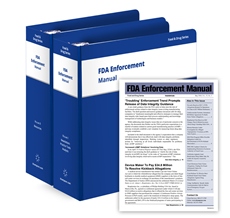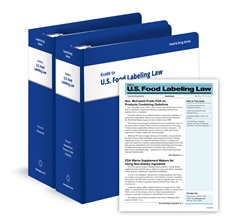
 FDA Enforcement Manual (Thompson FDA)*
Thompson's FDA enforcement manual is the comprehensive online resource guide to the Food and Drug Administration's enforcement authority, policies and practices for the drug, medical device, biologics, food, cosmetics and tobacco industries. Thompson's FDA enforcement manual will help you manage potentially expensive and time-consuming FDA enforcement activity by outlining the enforcement process; explaining the powers that the agency has during the process as well as the rights of companies and individuals targeted for enforcement action; and offering practical expert help on how to deal with FDA personnel and procedures.
FDA Enforcement Manual (Thompson FDA)*
Thompson's FDA enforcement manual is the comprehensive online resource guide to the Food and Drug Administration's enforcement authority, policies and practices for the drug, medical device, biologics, food, cosmetics and tobacco industries. Thompson's FDA enforcement manual will help you manage potentially expensive and time-consuming FDA enforcement activity by outlining the enforcement process; explaining the powers that the agency has during the process as well as the rights of companies and individuals targeted for enforcement action; and offering practical expert help on how to deal with FDA personnel and procedures.
 FDA Guide to Food Labeling Law (Thompson FDA)*
Thompson's guide to U.S. food labeling law is the most comprehensive and easy-to-use resource of its kind. The guide will help you understand and comply with FDA and USDA rules and regulations. It includes useable, timely and comprehensive information on federal labeling regulations and enforcement activities. The guide to U.S. food labeling law explains food labeling law and provides expert advice on what food processors must do to comply with the regulations to avoid enforcement actions. Also included are sections on the history of food labeling laws, the role various governmental agencies play in enforcing the rules, and the special rules that pertain to the labeling of dietary supplements.
FDA Guide to Food Labeling Law (Thompson FDA)*
Thompson's guide to U.S. food labeling law is the most comprehensive and easy-to-use resource of its kind. The guide will help you understand and comply with FDA and USDA rules and regulations. It includes useable, timely and comprehensive information on federal labeling regulations and enforcement activities. The guide to U.S. food labeling law explains food labeling law and provides expert advice on what food processors must do to comply with the regulations to avoid enforcement actions. Also included are sections on the history of food labeling laws, the role various governmental agencies play in enforcing the rules, and the special rules that pertain to the labeling of dietary supplements.
 Food and Drug Law
by
Roseann B. Termini
This food and drug law comprehensive book is organized for ease of reading in order to comprehend a complex area of federal regulatory law. There is a separate volume for each subject based on regulation under the United States Federal Food, Drug and Cosmetic Act (FDCA) and related laws all contained in this bound book. Food and Drug Law is organized into subject specific titled volumes with a concise introduction to provide a particular focus for the reader. Praise for Food and Drug LawFood and Drug law has many audiences besides lawyers - health care personnel, doctors, nurses, regulatory, and CEO's to name a few and the author writes in "Plain Language" for reader appeal. - Thomas Mc Grath, M.D., J.D. This is an excellent up-to-date resource. It is used in my graduate school courses as well as in industry. Students keep it as a "desk-top-reference." - Thomas E. Colonna PhD/JD, Director Regulatory Science Program The author details the complexities into subject specific areas. She provides critical information using a practical approach so rare today! - Albert Wertheimer, PhD. Prof. Nova Southeastern University
Food and Drug Law
by
Roseann B. Termini
This food and drug law comprehensive book is organized for ease of reading in order to comprehend a complex area of federal regulatory law. There is a separate volume for each subject based on regulation under the United States Federal Food, Drug and Cosmetic Act (FDCA) and related laws all contained in this bound book. Food and Drug Law is organized into subject specific titled volumes with a concise introduction to provide a particular focus for the reader. Praise for Food and Drug LawFood and Drug law has many audiences besides lawyers - health care personnel, doctors, nurses, regulatory, and CEO's to name a few and the author writes in "Plain Language" for reader appeal. - Thomas Mc Grath, M.D., J.D. This is an excellent up-to-date resource. It is used in my graduate school courses as well as in industry. Students keep it as a "desk-top-reference." - Thomas E. Colonna PhD/JD, Director Regulatory Science Program The author details the complexities into subject specific areas. She provides critical information using a practical approach so rare today! - Albert Wertheimer, PhD. Prof. Nova Southeastern University
* (Available on LEXIS or Westlaw, ID and password required)